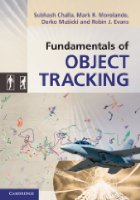 Kalman filter, particle filter, IMM, PDA, ITS, random sets . . . The number of useful object tracking methods is exploding. But how are they related? How do they help to track everything from aircraft, missiles and extra-terrestrial objects to people and lymphocyte cells? How can they be adapted to novel applications? Fundamentals of Object Tracking tells you how. Starting with the generic object tracking problem, it outlines the generic Bayesian solution. It then shows systematically how to formulate the major tracking problems - maneuvering, multi-object, clutter, out-of-sequence sensors - within this Bayesian framework and how to derive the standard tracking solutions. This structured approach makes very complex object tracking algorithms accessible to the growing number of users working on real-world tracking problems and supports them in designing their own tracking filters under their unique application constraints. The book concludes with a chapter on issues critical to the successful implementation of tracking algorithms, such as track initialization and merging"--Provided by publisher.
Kalman filter, particle filter, IMM, PDA, ITS, random sets . . . The number of useful object tracking methods is exploding. But how are they related? How do they help to track everything from aircraft, missiles and extra-terrestrial objects to people and lymphocyte cells? How can they be adapted to novel applications? Fundamentals of Object Tracking tells you how. Starting with the generic object tracking problem, it outlines the generic Bayesian solution. It then shows systematically how to formulate the major tracking problems - maneuvering, multi-object, clutter, out-of-sequence sensors - within this Bayesian framework and how to derive the standard tracking solutions. This structured approach makes very complex object tracking algorithms accessible to the growing number of users working on real-world tracking problems and supports them in designing their own tracking filters under their unique application constraints. The book concludes with a chapter on issues critical to the successful implementation of tracking algorithms, such as track initialization and merging"--Provided by publisher.
Machine generated contents note:
Preface;
1. Introduction to object tracking;
2. Filtering theory and non-manoeuvring object tracking;
3. Manoeuvring object tracking;
4. Single object tracking in clutter;
5. Single and multiple object tracking in clutter: existence based approach;
6. Multiple object tracking in clutter: random set based approach;
7. Bayesian smoothing algorithms for object tracking;
8. Object tracking with time delayed, out-of-sequence measurements;
9. Practical object tracking;
A. Mathematical and statistical preliminaries;
B. Finite set statistics;
C. Pseudo functions in object tracking; Bibliography;
Index.

 新书报道
新书报道